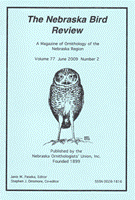Nebraska Ornithologists' Union

Nebraska Bird Review
Date of this Version
12-2014
Document Type
Article
Citation
Toll, "Summary of Raptor Banding Efforts at Hitchcock Nature Center, Fall 2014," from Nebraska Bird Review (December 2014) 82(4).
Abstract
The 2014 season was by far the most unusual and frustrating season since the inception of raptor banding and hawk watch at the Hitchcock Nature Center in Pottawatomie County, Iowa, just north of Crescent. Banding diurnal raptors commenced on September 7th on schedule. The month of September was typical as far as capture rates and weather systems, although we were stymied somewhat by the lack of availability of European Starlings for lure birds. House Sparrows proved a nearly adequate substitute.
During the peak period of October, weather systems that drive diurnal raptor migration worked against monitoring efforts by forcing migration on a broad front rather than concentrating migrants along the Loess Hills ridges where we monitor. As a result, diurnal raptor numbers were reduced by about 25% compared to average banding seasons. Species diversity of banded birds was perhaps the most disheartening aspect of the diurnal season. Only one American Kestrel was banded besides the typical three species that make up the bulk of our captures: Red-tailed Hawk, Sharp-shinned Hawk, and Cooper's Hawk. The one bright spot was the ratio of juvenile to adult Redtails banded. After a nearly 50-50 ratio of juveniles to adults in 2013, in 2014 the ratio was more typical of a successful breeding season (Beckett and Proudfoot 2011; Whalen and Watts 2002). It approached an 80-20 ratio of juveniles to adults.


Comments
Copyright 2014 Nebraska Ornithologists’ Union. Used by permission.